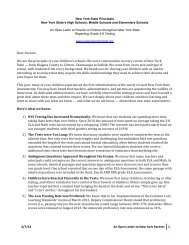Final_CA_Drought_Contingency_Plan-11-18-2010a
Final_CA_Drought_Contingency_Plan-11-18-2010a
Final_CA_Drought_Contingency_Plan-11-18-2010a
You also want an ePaper? Increase the reach of your titles
YUMPU automatically turns print PDFs into web optimized ePapers that Google loves.
California <strong>Drought</strong> <strong>Contingency</strong> <strong>Plan</strong>preparation for disaster response. With the exception of impacts to dryland farming andgrazing, drought impacts may occur slowly over seasonal periods, and the effects maylinger for years after the end of the event.In California, drought is commonly associated with impacts and below normalprecipitation. <strong>Drought</strong> impacts increase with the length of a drought, as water supplies inreservoirs are depleted and groundwater levels decline due to increased pumping. Theextent of drought impacts is dependent on many factors including climate, water usepatterns, available water supplies and geography.More discussion related to understanding drought and drought response in Californiacan be found in the article “<strong>Drought</strong>s Concepts and Impacts in California” (SeeAttachment 3). This article also describes drought impacts on different sectors in greaterdetail, including predicted outcomes from climate change.UIII. HISTORI<strong>CA</strong>L DROUGHT AND CLIMATE CHANGE<strong>Drought</strong>s exceeding three years in California’s measured hydrologic record have beenrelatively rare in Northern California, which is where the majority source of the State’swater supply originates. Historical multi-year droughts include: 1912-13, 19<strong>18</strong>-20, 1923-24, 1929-34, 1947-50, 1959-61, 1976-77, 1987-92, and most recently the currentdrought which began in 2007. The 1929-34 <strong>Drought</strong> established the criteria commonlyused in designing storage capacity and yield of large Northern California reservoirs.In addition to historical measured data, scientists are now reconstructing historicalweather conditions through analysis of tree rings (dendrochronology). Information onthe thickness of annual growth rings can be used to infer historical weather andstreamflow conditions. Some of the longest and best reconstructions have beendeveloped for the Colorado River spanning more than 1,000 years. Thesereconstructions clearly show extended drought periods that are far more severe thananything experienced in the historical record. The recent drought and new informationabout drought patterns in the past 1,000 years have raised awareness of the need toaddress the possibility of long-term, sustained drought.Warming temperatures due to global climate change, combined with changes inprecipitation and runoff patterns, are projected to increase the frequency and intensity ofdroughts in California. Regions that rely heavily upon surface water (rivers, streams,and lakes) could be particularly affected as runoff becomes more variable, and moredemand is placed on groundwater. Climate change and a projected increase inCalifornia’s population will also affect water demand. Warmer temperatures will likelyincrease evapotranspiration rates and extend growing seasons, thereby increasing theamount of water that is needed for the irrigation of many crops, urban landscaping andenvironmental water needs.3






